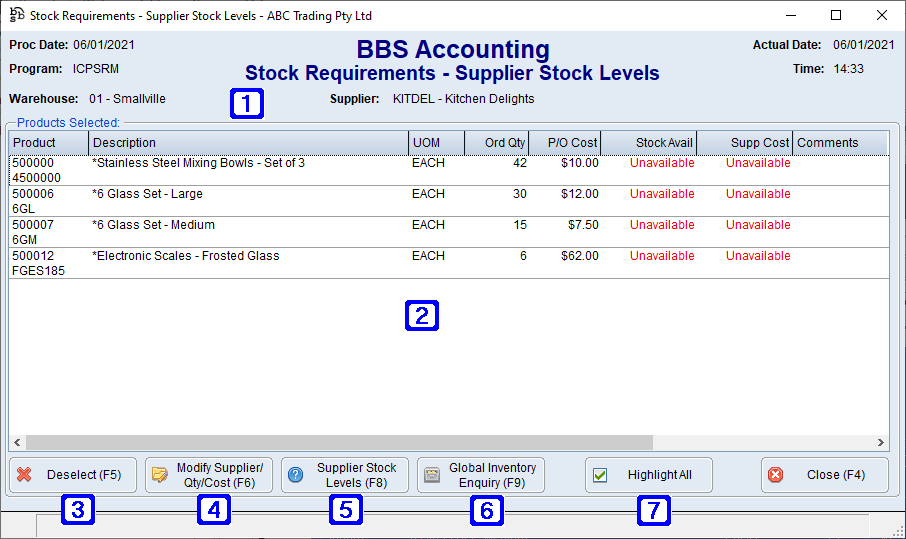|
Main Menu > Purchase Ordering > Stock Requirements Manager |
The Stock Requirements Manager allows a user to view all products that require replenishment in a chosen warehouse based on the filters selected. A user can select to view only items required to fill backorders, items required to fill backorders and/or that are below the minimum stock holding level or weeks of stock target.
Products that require replenishment are then 'selected' to be ordered from the default supplier, ordered from a different supplier, transferred from another warehouse, transferred from another product code or built from other products. The breakdown of a requirement for a product can be viewed showing what quantity is required for each individual backorder, and what quantity is required for stock. Each individual backorder, and/or the quantity required for stock, can be set to be purchased or transferred from different sources.
Once a user is finished making all selections, purchase orders are then raised supplier-by-supplier, and stock transfers are raised warehouse-by-warehouse, and product-by-product, and build orders can be raised per product.

Stock Requirements Manager Screen
|
W/H Code – The warehouse code to manage. Only a single warehouse can be managed at a time, and only a single user can be managing any one warehouse at any one time. (This restriction is designed to eliminate the accidental duplication of purchase orders). |
|
|
Recalc (F3) – Recalculates stock requirements in the selected warehouse. A Recalc gathers all the data on products with backorders, purchase orders, and minimum/maximum stock holding levels and saves this data in the Stock Requirements Manager work files. The data that is saved in the work files is a snapshot of stock levels and product statuses at the time the last recalc was performed. Once a recalc is performed, actions outside of this screen such as creating sales orders, invoicing, creating purchase orders manually etc are not reflected in the figures until another recalc is performed, however, selections made, purchase orders raised and transfers processed from within the Stock Requirements Manager will update the stock figures in the Stock Requirements Manager immediately. Users can select to include backorders on hold and/or backorders on credit hold as well as choosing a single supplier.
Include Backorders on Credit Hold – When ticked, this option will include backorders that are on credit hold in the calculations and will therefore prompt users to buy in the items. If unticked, backorder items will not be ordered in until an order is released from credit hold. Include Backorders Placed on Hold - When ticked, this option will include backorders that users have 'Placed on Hold' in the Sales Ordering system in the calculations and will therefore prompt users to buy in the items. If unticked, backorder items will not be ordered in until an order is taken off hold. Single Supplier – When left blank, all products for all suppliers are calculated for reorder and are displayed against the default supplier. When a Single Supplier is selected for Recalc, BBS will search for all products where that supplier is either the default supplier, or a secondary supplier, and display the product as if the entered supplier was the default supplier. This option can be used to find ALL products that COULD be purchased from a given supplier when trying to achieve a minimum order value. Override Product Weeks of Stock - When ticked users can override the current system settings for the 'Weeks of Stock' calculations by entering the number of 'Weeks of Stock' they wish to run the calculation for. |
|
|
Last Calc – Date, time and user of last recalc performed in the selected warehouse |
|
|
Purch Comment – Navigates users to the Purchasing Comments pop up that require attention. Please refer to Purchasing Comments for more information. Directs - Navigates users to the Direct Delivery Sales Orders that require attention. Please refer to Direct Deliveries for more information. EBI's - Navigates users to the Exclusive Buy-In Sales Orders that require attention. Please refer to Exclusive Buy-Ins (EBI's) for more information. |
|
|
Filter – A user can filter the stock requirements to show only the items they are interested in at any one time. |
Required for Backorders – This option will show only the items and quantities that are required to satisfy current customer backorders. B/O & Below Minimum – This option will show the items and quantities that are required to satisfy current backorders, and all products that are below their minimum stock holding levels. This option is the default. B/O & Below Maximum – This option will show the items and quantities that are required to satisfy current backorders, and all products that are below their maximum stock holding levels. This option is usually only used when attempting to locate additional products that can be purchased to meet a supplier’s minimum order value. B/O & Below WoS Target - This option will show the items and quantities that are required to satisfy current backorders, and all products that are below their 'Weeks of Stock Target' (weighted average weekly usage X weeks of stock) holding levels. |
|
Search – Allows users to search for a keyword to filter the list (eg. part of a product description) |
|
|
Reload - Will reload the items in the screen (does not perform a recalc, just refreshes the screen) |
|
|
A notation to display if the data displayed is for all suppliers or only a single supplier. |
|
|
Products Required - All items matching the current filters and search terms that still have an unsatisfied requirement are displayed in the Products Required list, in order by default supplier |
Product – The BBS Code and product description. An asterisk (*) prior to a product description denotes a core product/stocked item. Supplier – The default supplier for the product UOM – The stock/standard unit of measure for the product Avail – The quantity available (On Hand less Committed less On Consignment) B/O – The quantity on backorder. If the figure in this column is highlighted in RED, one or more backorders for this product have a purchasing comment that should be reviewed prior to selecting this product. P/O – The quantity on purchase order, plus any quantities already selected for order or transfer. Where a quantity or quantities of this product have already been selected for order or transfer, this figure will be displayed in MAGENTA. Req’d – The quantity required to satisfy the selected filter. MOQ – The default supplier’s minimum order quantity/economical order quantity. If the 'Req’d' quantity is not a multiple of the supplier’s MOQ, this may alter the quantity that will actually be ordered. Usg – The weighted average weekly usage (sales and transfers out) of the product. OWH – The quantity of this product that is available in other warehouses shown on the first line, and the quantity on order in other warehouses, excluding all WHTFR (Internal Stock Transfer) purchase orders shown on the second line in Magenta. Src P/C – The quantity of the source product that is available where a source product is linked to the product required. The quantity shown is in the required products UOM (ie. the conversion factor has already been applied). Narration – A text narration alerting to something regarding this product. Examples are: 'Purchasing comments exist on backorders' – This message alerts users to backorders that have purchasing comments. The individual purchasing comments can be viewed in the 'View/Edit Breakdown' screen. 'Source Product has sufficient/insufficient available stock to satisfy requirements' – This message alerts users whether or not the requirements of this product can be satisfied by transferring some stock from the linked source product (usually a separate product code created for a carton quantity of a product). users can then determine whether or not to transfer some stock from the source product to this product to satisfy the requirements. '! P/O Alerts Exist !' – This message alerts users that the product in question has active 'purchasing alerts'. users can click either Select Alternate Supplier/Qty or View/Edit Breakdown to see the alerts. |
Product descriptions that are displayed in RED denote a product where a quantity is required for backorders. Product descriptions that are displayed in BLUE denote a product where a quantity is required for stock as the product has dropped below the minimum stock holding level, or the WoS Target. Product descriptions displayed in BLACK denote a product where a quantity can be ordered to fill the product back up to the maximum level even though it has not yet dropped below the minimum level. The list can be re-sorted at any time by clicking any of the column headings. For example, if a user is trying to make a supplier’s minimum order value, they may sort the list by the 'Usg' column to see the most active products that can be ordered. Multiple products can be highlighted by using the mouse and the CTRL or SHIFT keys on the keyboard. Certain options are not available, or are only partially available, when multiple products are highlighted. |
||
|
Select (F5) - Selects the highlighted product/s to be ordered from the default supplier (or built if the default supplier is the BOM Vendor), by the quantity displayed in the 'Req’d' column (plus any additional amount required to meet the MOQ), and using the default supplier’s future or current promotional cost. Once selected, the products will disappear from the Products Required list and the View/Edit Selected & Create Orders button will turn GREEN |
|
|
Select Alternate Supplier/Qty (F6) - Allows users to modify a source/supplier, quantity or cost on a selected product. Users can also select a product by double clicking the line in the Products Required list which will bring up the Select Alternate Supplier/Qty screen. Please refer to Select Alternate Supplier/Qty for more information. |
|
|
View/Edit Breakdown (F7) - When a user wishes to source portions of a requirement for a single product from different sources, or at different costs, they can highlight that product and click the View/Edit Breakdown (F7) button, or press F7 on the keyboard. Please refer to View/Edit Breakdown for more information. |
|
|
Supplier Stock Levels (F8) - Navigates users to the Supplier Stock Levels screen of the selected product (if set up in your system). This option is not available when multiple products are highlighted. |
|
|
Global Inventory Enquiry (F9) - Navigates users to the Global Inventory Enquiry of the selected product. This option is not available when multiple products are highlighted. |
|
|
Product Maintenance - Navigates users to Product Maintenance of the selected product. This option is not available when multiple products are highlighted. |
|
|
Product Information - Displays the product information for the highlighted product - •Prod – The product description •UOM – The stock/standard unit of measure for the product •Int Desc – The internal description for the product. This can be used for special internal notations regarding this product and is set on the Product Masterfile. •Qty Avail – As per the Avail column •Qty B/O – As per the B/O column •Qty P/O – As per the P/O column •F’cast – The stock forecast quantity (Qty Avail less Qty B/O plus Qty P/O). A negative forecast quantity is displayed in red and denotes the quantity that is required to satisfy current backorders. •Manf Code – The manufacturer’s part number for the product •WoS Req - The number of weeks of stock of this product that should be held •WoS Target - The quantity of stock that should be held •Min Stk – The minimum stock holding quantity for the product •Max Stk – The maximum stock holding quantity for the product •Mnthly Sales – Starting at the current month, and working back a further twelve months, this field displays that quantity of this product that was sold each month, separated by commas. •Req’d – As per the Req’d column •Narration – As per the Narration column, however this field displays additional details that may not fit in the narration column in the Products Required List. |
|
|
Displays Supplier details for the selected product - When a single product is highlighted, the supplier details list on the screen is populated with all the suppliers in the system for that product, any details regarding the quantity available and cost of this product in other warehouses, and the details regarding the quantity available and cost of the parent product (where applicable). The columns displayed are: •Supplier – The supplier code and name, or other source for the product (eg a parent product or another warehouse). •Fut Cost – The current future cost for this supplier for the selected product; or the average cost of this product in other warehouses; or the average cost of the parent product divided by the parent-child conversion factor. •Last Purch/Stock – The top line will display the last receipt date for this product from this supplier; or the quantity available in other warehouses; or the quantity available in the parent product. For suppliers with live or overnight stock level updates, the bottom line will display the supplier's stock levels along with the date the stock levels were last updated. Double clicking a supplier will allow users to purchase the highlighted product from this supplier instead of the product's default supplier. •MOQ – The supplier’s MOQ for this product •Diff – The difference in cost, either positive or negative, against the default supplier’s future cost. Supplier details that are displayed in BLUE are for the default supplier. Supplier details that are displayed in MAGENTA show a current promotional cost price for the supplier in question. |
|
|
View/Edit Selected & Create Orders (F12) - Navigates users to the Stock Requirements – Selected Items window. Please refer to Stock Requirements - Selected Items for more information. |
|
To select an alternate source (alternate Supplier (Purchase Order), Another Warehouse (Stock Transfer), Another Warehouse (via Purchase Order), Another Product (Stock Transfer), Bill of Materials (Build Item) different cost or quantity for a single product, users can highlight that product and click the Select Alternate Supplier/Qty (F6) button, or press F6 on the keyboard.
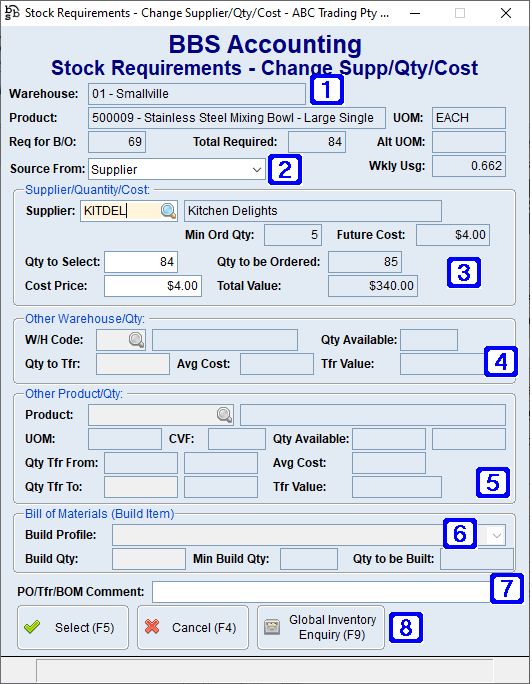 Stock Requirements - Change Supp/Qty/Cost Screen (Single item selected)
Select Alternate Source/Supplier for multiple products: To select an alternate source or supplier for multiple products, users can highlight the products and click the Select Alternate Supplier (F6) button, or press F6 on the keyboard. users can select a source either Supplier (Purchase Order), Another Warehouse (Stock Transfer) or Another Warehouse (via Purchase Order).
 Stock Requirements - Change Supp/Qty/Cost Screen (Mulitiple Items selected)
|
When a user wishes to source portions of a requirement for a single product from different sources, or at different costs, they can highlight the product and click the 'View/Edit Breakdown (F7)' button, or press F7 on the keyboard. Each backorder that has a requirement for this product, as well as any requirements for stock are displayed in the Requirements list. Any purchasing comments that are entered against these backorders are displayed and should be reviewed.
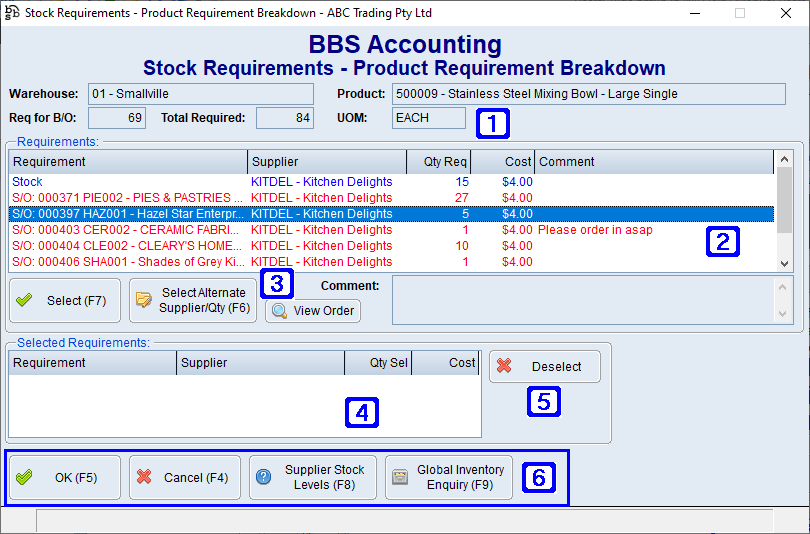 Stock Requirements - Product Requirement Breakdown Screen
|
 Stock Requirements - Selected Items
Stock Requirements - Selected Items
 Stock Requirements - Selected Items Screen
|
The Purch Comments button at the top of the Stock Requirements Manager allows users to access all unactioned purchasing comments. Purchasing decisions can then be made based on these purchasing comments prior to performing general purchasing. Where a Preferred Supplier was entered on the sales order, this supplier will be automatically selected as the supplier to order the goods from. While similar to the red blocks in the B/O column, this screen will display ALL purchasing comments for backorders regardless of the state of the product. This ensures the purchasing department see all purchasing comments, even if the product is already on order from a supplier.
This feature should be used to eliminate timing issues users may experience with the Stock Requirements Manager. An example scenario is: A product is a stocked item and is on order from a primary supplier with a lead-time of two days. An urgent sales order for this product is processed, it must be purchased from a local wholesaler for same-day delivery and a purchasing comment is entered to inform the purchasing department of this. While this product may not show in the main stock requirements manager screen as some of the product is already on order, it will display in the Purchasing Comments screen to be actioned.
 Stock Requirements - Purchasing Comments Screen
|
 Direct Deliveries & Exclusive Buy-Ins
Direct Deliveries & Exclusive Buy-Ins
Direct Delivery sales orders and Exclusive Buy-In sales orders, where the required quantity of products have not already been ordered, will be displayed in the two buttons at the top right-hand corner of the main Stock Requirements Manager screen. Where a Preferred Supplier was entered on the sales order, this supplier will be automatically selected as the supplier to order the goods from.
Where a product is 'over-ordered' on a direct delivery, ie the quantities on the linked purchase orders are greater than the quantity on the D/D sales order, these will also be displayed.
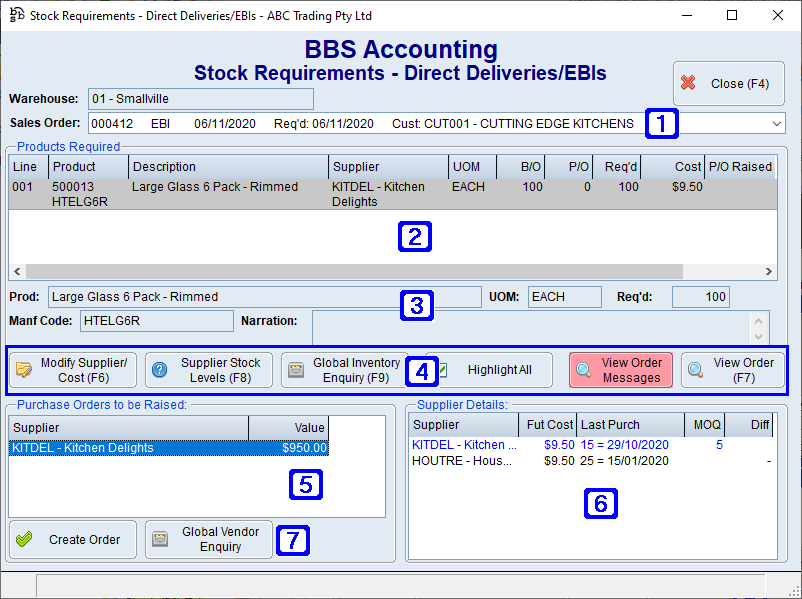 Stock Requirements - Direct Deliveries/EBIs Screen
|




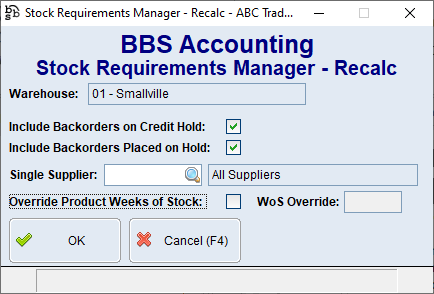
















 to search
to search